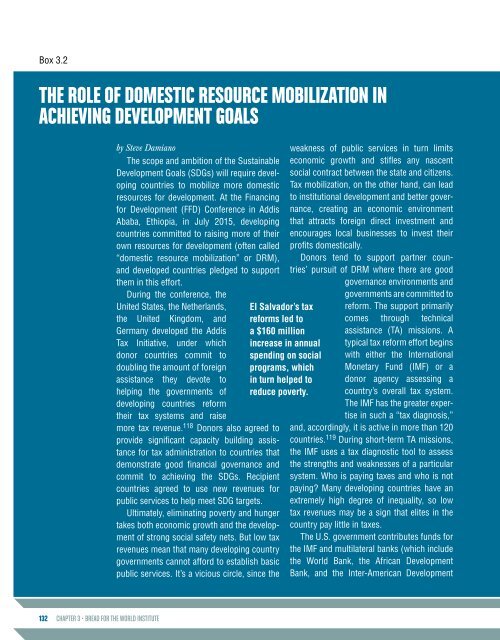THE NOURISHING EFFECT
HR2016-Full-Report-Web
HR2016-Full-Report-Web
Create successful ePaper yourself
Turn your PDF publications into a flip-book with our unique Google optimized e-Paper software.
Box 3.2<br />
<strong>THE</strong> ROLE OF DOMESTIC RESOURCE MOBILIZATION IN<br />
ACHIEVING DEVELOPMENT GOALS<br />
by Steve Damiano<br />
The scope and ambition of the Sustainable<br />
Development Goals (SDGs) will require developing<br />
countries to mobilize more domestic<br />
resources for development. At the Financing<br />
for Development (FFD) Conference in Addis<br />
Ababa, Ethiopia, in July 2015, developing<br />
countries committed to raising more of their<br />
own resources for development (often called<br />
“domestic resource mobilization” or DRM),<br />
and developed countries pledged to support<br />
them in this effort.<br />
During the conference, the<br />
United States, the Netherlands,<br />
the United Kingdom, and<br />
Germany developed the Addis<br />
Tax Initiative, under which<br />
donor countries commit to<br />
doubling the amount of foreign<br />
assistance they devote to<br />
helping the governments of<br />
developing countries reform<br />
their tax systems and raise<br />
more tax revenue. 118 Donors also agreed to<br />
provide significant capacity building assistance<br />
for tax administration to countries that<br />
demonstrate good financial governance and<br />
commit to achieving the SDGs. Recipient<br />
countries agreed to use new revenues for<br />
public services to help meet SDG targets.<br />
Ultimately, eliminating poverty and hunger<br />
takes both economic growth and the development<br />
of strong social safety nets. But low tax<br />
revenues mean that many developing country<br />
governments cannot afford to establish basic<br />
public services. It’s a vicious circle, since the<br />
El Salvador’s tax<br />
reforms led to<br />
a $160 million<br />
increase in annual<br />
spending on social<br />
programs, which<br />
in turn helped to<br />
reduce poverty.<br />
weakness of public services in turn limits<br />
economic growth and stifles any nascent<br />
social contract between the state and citizens.<br />
Tax mobilization, on the other hand, can lead<br />
to institutional development and better governance,<br />
creating an economic environment<br />
that attracts foreign direct investment and<br />
encourages local businesses to invest their<br />
profits domestically.<br />
Donors tend to support partner countries’<br />
pursuit of DRM where there are good<br />
governance environments and<br />
governments are committed to<br />
reform. The support primarily<br />
comes through technical<br />
assistance (TA) missions. A<br />
typical tax reform effort begins<br />
with either the International<br />
Monetary Fund (IMF) or a<br />
donor agency assessing a<br />
country’s overall tax system.<br />
The IMF has the greater expertise<br />
in such a “tax diagnosis,”<br />
and, accordingly, it is active in more than 120<br />
countries. 119 During short-term TA missions,<br />
the IMF uses a tax diagnostic tool to assess<br />
the strengths and weaknesses of a particular<br />
system. Who is paying taxes and who is not<br />
paying? Many developing countries have an<br />
extremely high degree of inequality, so low<br />
tax revenues may be a sign that elites in the<br />
country pay little in taxes.<br />
The U.S. government contributes funds for<br />
the IMF and multilateral banks (which include<br />
the World Bank, the African Development<br />
Bank, and the Inter-American Development<br />
132 CHAPTER 3 • BREAD FOR <strong>THE</strong> WORLD INSTITUTE


